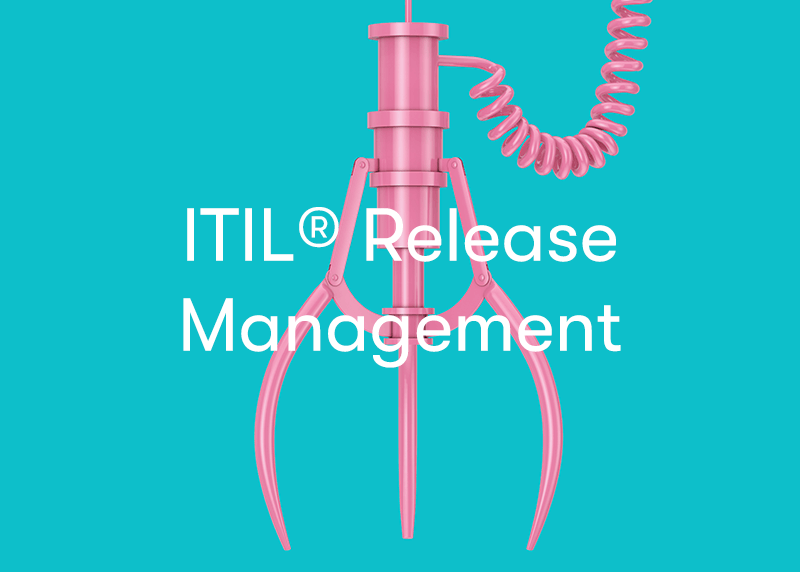ITIL 4 release management builds upon the principles and concepts of previous versions, but it also incorporates new practices and approaches. The key focus of ITIL 4 release management is to ensure the successful planning, coordination, and deployment of releases, while minimising risks and disruptions to the IT services.
ITIL® Release Management
Release management is a part of ITIL4’s 34 practices, under the service management practice category. To check out more of the practices check our ITIL practices blog.
ITIL 4 release management emphasises the need for collaboration, continuous improvement, and the adoption of agile practices. It recognises the importance of automation, DevOps principles, and the use of technology to enable more efficient and reliable release processes.
ITIL 4 release management aims to facilitate the delivery of high-quality IT services by ensuring that releases are well-planned, controlled, and aligned with the organisation's business goals and objectives.
What is ITIL® Release Management?

ITIL® release management is a practice within the IT service management framework that focuses on the planning, coordination, and control of software releases, updates, and changes within an organization's IT infrastructure. The primary objective of ITIL release management is to ensure the smooth and efficient delivery of changes into the operational environment while minimising risks and disruptions to IT services. By following ITIL release management practices, organisations can achieve more efficient and controlled release processes, resulting in improved service quality and customer satisfaction.
What is the Definition of a Release?
ITIL4 defines a release as “A version of a service or other configuration item, or a collection of configuration items, that is made available for use.” For more definitions, please check our glossary free resource.
I would describe a ‘release’ in ITIL as the deployment and introduction of new or modified software, hardware, or IT services into an organisation's operational environment. It involves the planning, coordination, testing, and implementation of changes, ensuring they are delivered smoothly while minimising disruptions and risks.
An ITIL release encompasses various components, such as application updates, patches, configurations, and documentation. It aims to maintain service continuity, enhance the performance and functionality of IT systems, and align with business needs. Effective release management follows best practices, including rigorous testing, proper communication, and collaboration among stakeholders, to ensure successful and efficient implementation.
Why is Release Management Important?

ITIL release management is important as it ensures that changes are delivered smoothly, enhances service quality, aligns with business objectives, enables effective change control, facilitates collaboration, increases efficiency and agility, and promotes continuous improvement within an organization's IT environment. ITIL release management is important for several reasons:
Minimising Disruptions
Effective release management ensures that new or modified software, hardware, or IT services are introduced into the operational environment with minimal disruptions to ongoing operations. It helps mitigate risks and avoids unforeseen issues that could negatively impact the availability and performance of IT services.
Enhancing Service Quality
By following structured release management processes, organizations can ensure that changes are thoroughly tested, validated, and deployed in a controlled manner. This helps to maintain and enhance the quality of IT services, reducing incidents, errors, and service disruptions.
Aligning with Business Objectives
Release management aligns IT changes with the strategic goals and objectives of the organization. It ensures that releases are prioritized based on business needs, enabling the delivery of value-added features and improvements that directly contribute to the organisation's success.
Enabling Effective Change Control
Release management works closely with the change management process (change enablement in ITIL4 terminology) to ensure that changes are properly assessed, authorized, and coordinated. It helps maintain a clear audit trail, enabling organisations to track and understand the impact of changes, comply with regulatory requirements, and ensure accountability.
Facilitating Collaboration and Communication
Release management involves collaboration among various stakeholders, including development teams, operations teams, vendors, and users. It promotes effective communication, coordination, and knowledge sharing, reducing misunderstandings and enhancing cooperation across different groups.
Increasing Efficiency and Agility
By adopting best practices and automation tools, release management helps organisations improve the efficiency of their release processes. It facilitates the adoption of agile methodologies, DevOps practices, and continuous integration/continuous deployment (CI/CD) pipelines, enabling faster, more frequent, and more reliable releases.
Continuous Improvement
Release management includes evaluating the success and effectiveness of releases through post-implementation reviews and gathering user feedback. This information is used to drive continuous improvement in the release processes, identifying areas for optimisation and learning from past experiences.
What is the Process Flow for Release Management?

The ITIL 4 release management process flow consists of several key steps:
Identify Release Requirements
This step involves understanding the business needs and objectives that drive the release. It includes gathering requirements, assessing risks, and identifying dependencies.
Plan and Design the Release
In this step, the release is planned and designed based on the identified requirements. This includes defining release scope, scheduling activities, allocating resources, and creating a release plan.
Build and Configure the Release
The release is built and configured according to the release plan. This involves developing or modifying the necessary software, hardware, or IT services, and ensuring proper testing and quality assurance. Build and various technical and platform teams may be involved in carrying out this activity.
Test the Release
The release is thoroughly tested to ensure its functionality, performance, and compatibility with existing systems and services. Testing includes various activities, such as unit testing, integration testing, system testing, and user acceptance testing. Release management oversee the testing and are not normally involved in hands-on testing.
Coordinate and Approve the Release
This step involves coordinating with stakeholders, such as change management/enablement, service desk, and operations teams, to obtain the necessary approvals for the release. This ensures proper coordination and alignment with other IT processes.
Schedule and Communicate the Release
The release is scheduled for deployment, and communication plans are developed to inform users, stakeholders, and affected parties about the release schedule, expected changes, and potential impacts.
Deploy and Verify the Release
The release is deployed into the operational environment following the scheduled timeline. The deployment process is closely monitored to ensure its successful completion. After deployment, the release is verified to confirm that it is functioning as expected.
Review and Evaluate the Release
Post-implementation reviews are conducted to assess the success of the release and gather feedback from users and stakeholders. This information is used to identify areas for improvement and support continuous improvement efforts.
Update Release Documentation
Documentation related to the release, such as release notes, configuration management records, and operational manuals, is updated to reflect the changes made and to provide accurate information for future reference.
Close the Release
The release management process is formally closed, and any remaining activities, such as archiving documentation, closing change records, and conducting lessons learned sessions, are completed.
It's important to note that the specific steps and their sequence may vary depending on the organisation's practices, size, and complexity of releases. Various release ‘models’ may be developed to handle different types of release. The ITIL 4 release management process flow provides a general framework that can be tailored to meet specific organisational needs and requirements.
What Are the Best Practices for Release Management?

Here are some best practices for ITIL 4 release management:
Clearly Define Release Policies and Procedures
Establish clear policies and procedures that govern the release management process. Document the roles, responsibilities, process interfaces, and authorities of individuals involved in the process.
Adopt a Release Management Framework
Implement a structured release management framework, aligning with the ITIL 4 guidelines. This ensures consistency, efficiency, and standardization in the release management process.
Integrate Release Management with Change Management
Coordinate closely with change management to ensure that releases are properly assessed, authorized, and coordinated. Maintain a clear linkage between change requests and releases to manage dependencies effectively.
Embrace Agile and DevOps Practices
Adopt agile methodologies and DevOps practices were appropriate to enhance the speed and efficiency of releases. Use automation tools, continuous integration, and continuous deployment (CI/CD) pipelines to enable faster and more frequent releases while maintaining quality.
Perform Comprehensive Release Planning
Thoroughly plan and document the release scope, objectives, timeline, and required resources. Consider business priorities, risks, dependencies, and the impact on stakeholders to develop a well-defined release plan.
Conduct Rigorous Testing and Validation
Implement robust testing strategies to ensure the functionality, performance, and compatibility of the release. Perform unit testing, integration testing, system testing, and user acceptance testing to identify and rectify any issues before deployment.
Establish Release Communication Channels
Implement effective communication channels to inform users, stakeholders, and affected parties about the release schedule, changes, and potential impacts. Provide clear and timely communication to manage expectations and minimize disruptions.
Maintain a Release Knowledge Base
Develop and maintain a knowledge base or repository of release-related information, including release documentation, configuration items, known issues, and lessons learned. This helps facilitate future releases and provides valuable insights for improvement.
Monitor and Measure Release Performance
Continuously monitor and measure the performance of releases against predefined metrics and key performance indicators (KPIs). Identify areas for improvement, track the success of releases, and use feedback to enhance future release cycles.
Encourage Collaboration and Continual Improvement
Foster collaboration among stakeholders, including development teams, operations teams, vendors, and users. Encourage feedback, conduct post-implementation reviews, and leverage lessons learned to drive continuous improvement in the release management process.
By following these best practices, organisations can enhance the efficiency, reliability, and value of their release management process, resulting in improved service delivery and customer satisfaction.
What Are the Objectives of ITIL 4 Release Management?

ITIL 4 release management helps organisations deliver changes and releases effectively, ensuring the stability, reliability, and continuous improvement of IT services while aligning with business needs. The objectives of ITIL 4 release management are as follows:
Ensure Smooth and Controlled Deployment
The primary objective of ITIL 4 release management is to ensure that changes, updates, or new services are deployed into the operational environment in a smooth and controlled manner. This helps minimise disruptions, maintain service continuity, and reduce the risk of adverse impacts on IT services. Smooth deployments also support customer/user satisfaction who tend not to appreciate disruption to their services.
Minimise Risks and Disruptions
Release management aims to minimise risks associated with changes by conducting thorough planning, testing, and validation. It helps identify and mitigate potential risks and dependencies, ensuring that releases are implemented without causing disruptions or incidents in the IT environment.
Enhance Service Quality
Release management focuses on maintaining and enhancing the quality of IT services. It ensures that releases are thoroughly tested, validated, and meet the defined requirements and service levels. By implementing releases effectively, organisations can improve service performance, reliability, and customer satisfaction.
Align with Business Objectives
ITIL 4 release management aims to align changes and releases with the strategic goals and objectives of the organisation. It ensures that releases are prioritised based on business needs, enabling the delivery of value-added features, improvements, and innovations that support business objectives.
Enable Efficient Change Control
Release management works closely with the change management/enablement process to ensure that changes are properly assessed, authorized, and coordinated. It helps maintain proper change control procedures, ensuring that only authorized and tested releases are deployed into the operational environment.
Foster Collaboration and Communication
Release management promotes collaboration and effective communication among stakeholders, including development teams, operations teams, vendors, and users. It facilitates coordination, knowledge sharing, and transparent communication to ensure that all parties are aligned and informed throughout the release process.
Drive Continual Improvement
Release management incorporates a culture of continual improvement. It emphasises learning from previous releases, gathering feedback from users and stakeholders, conducting post-implementation reviews, and applying lessons learned to enhance future release cycles.
What Release Management Metrics Should You Track?

Tracking relevant metrics is crucial for assessing the performance and effectiveness of ITIL 4 release management. Here are some key metrics that can be tracked:
Release Success Rate
This metric measures the percentage of releases that are successfully deployed without major incidents or disruptions. It provides an overall view of the effectiveness of the release management process.
Release Deployment Frequency
This metric indicates how frequently releases are deployed within a given time frame. It helps assess the agility and responsiveness of the release management process.
Release Lead Time
This metric measures the time taken from the initiation of a release request to its deployment. It helps evaluate the efficiency of the release management process and identify bottlenecks or delays.
Defects or Issues Introduced
This metric tracks the number of defects or issues identified after a release has been deployed. It helps assess the quality of releases and identify areas for improvement in testing and validation processes.
Change Failure Rate
This metric measures the percentage of changes or releases that result in incidents or service disruptions. It helps identify potential risks and weaknesses in the release management process.
Backlog of Pending Releases
This metric tracks the number of pending releases awaiting deployment. It helps assess the workload and capacity of the release management team and identify potential resource constraints.
Release Rollback Rate
This metric measures the frequency of rollback or reverting back to a previous release due to issues or failures. It indicates the stability and reliability of the release management process and the effectiveness of testing and validation activities.
User Satisfaction with Releases
This metric assesses user satisfaction levels following the deployment of releases. It can be measured through surveys, feedback, or user satisfaction ratings. It helps gauge the impact and value of releases from a user perspective.
Compliance with Release Policies
This metric measures the adherence to release management policies, procedures, and regulatory requirements. It ensures that releases are deployed in a controlled and compliant manner.
Release Schedule Adherence
This metric tracks the adherence to the planned release schedule, comparing the actual deployment dates with the scheduled dates. It helps evaluate the effectiveness of planning and coordination in the release management process.
It's important to select metrics that align with the specific objectives and priorities of the organisation. Regularly monitoring and analysing these metrics can provide valuable insights for continuous improvement and enable better decision-making in ITIL release management.
Where Can You Learn More?
Explain that the course will be live soon and that they should sign-up for the newsletter to be notified of when it launches. Link to somewhere they can signup for the newsletter.
Also, make a note to come back and edit this section when the course goes live.
Our one-day ITIL® 4 Practitioner: Release Management training course provides guidance on key activities and strategy for release management, including release planning, testing, deployment, and post-release evaluation. These practices help organisations streamline the release process, improve service delivery, and achieve better overall IT service management outcomes.
Our ITIL® 4 Practitioner: Release Management training course is available from July 2023.
Release is also part of the ITIL Specialist: Plan, Implement and Control. If you would like to register your interest, please complete this form.
Final Notes Release Management and ITIL
ITIL 4 release management is a practice focused on planning, coordinating, and controlling software releases, updates, and changes within an organisation's IT infrastructure. Its primary goal is to ensure smooth and efficient delivery of changes while minimizing risks and disruptions to IT services.
One of the key benefits of ITIL 4 release management is improved service quality. By following structured release management processes, organisations can enhance the quality of IT services. Thorough testing, validation, and coordination reduce incidents and errors, leading to improved service performance and customer satisfaction.
Another benefit is minimising disruptions and risks. Effective release management ensures smooth deployment by rigorous planning, testing, and coordination. It helps identify and mitigate risks, ensuring that releases are implemented without adverse impacts on IT services.
Release management also aligns changes and releases with business objectives. By prioritising releases based on business needs, organisations deliver value-added features and improvements that support their strategic goals.
Efficient change control is another advantage of release management. It works closely with change management processes, ensuring proper assessment, authorization, and coordination. This enables organisations to have efficient change control, deploying only authorised and tested releases.
Lastly, ITIL 4 release management promotes a culture of continuous improvement. Through post-implementation reviews, feedback gathering, and lessons learned, organisations can optimise their release management processes, learn from past experiences, and drive ongoing enhancements.
In summary, ITIL 4 release management enables organisations to deliver changes effectively, maintain service quality, minimise disruptions and risks, align with business objectives, and drive continuous improvement.
For more information on ITIL 4 release management, why not check out our one-day ITIL® 4 Practitioner: Release Management course for only £595 + VAT.



